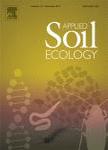版权所有:内蒙古大学图书馆 技术提供:维普资讯• 智图
内蒙古自治区呼和浩特市赛罕区大学西街235号 邮编: 010021

作者机构:Chinese Acad Sci Inst Soil Sci Nanjing 210008 Peoples R China Univ Chinese Acad Sci Beijing 100049 Peoples R China Qingdao Agr Univ Coll Resources & Environm Qingdao 266109 Peoples R China Univ Chinese Acad Sci Nanjing 211135 Peoples R China
出 版 物:《APPLIED SOIL ECOLOGY》 (Appl. Soil Ecol.)
年 卷 期:2024年第203卷
核心收录:
学科分类:09[农学] 0903[农学-农业资源与环境]
基 金:National Natural Science Foundation of China China Agriculture Research System of MOF and MARA [CARS-03] Project of Transferring Water from Yangtze River to Huaihe River
主 题:Fusarium graminearum Crop residue return Organic stimulants Soil microbial community Fusarium head blight
摘 要:Application of crop residues combined with an organic stimulant has been previously proven to promote residue decomposition through stimulating microbial decomposers, while little is known about whether the residueborne Fusarium graminearum (Fg) from the soil concurrently changed. A one-year wheat field experiment was conducted to investigate how the stimulant-induced changes in soil properties, bacterial and fungal community compositions affected the soil Fg abundance. Four treatments were designed including (1) combined application of crop residues (R) and an organic stimulant (S) (RS), (2) only R was applied (R), (3) only S was applied (S), and (4) an unamended control (R0S0). No Fg was determined from the R0S0 soil. Among the other three treatments, the R and S had similarly highest levels of the soil Fg abundance, with the average values being 136.71 % higher than that from the RS treatment, which was mainly regulated by declining soil pH and the enrichment of the fungal taxa associated with crop residue decomposition and biocontrol induced by increasing DOC in the RS treatment. Likewise, the FHB disease incidence from the RS treatment was 9.77 % lower than that from the R and S. We demonstrated that combination application of crop residues and an organic stimulant showed effectiveness in reducing the Fg abundance in soil and FHB disease incidence in wheat due to the stimulant-induced changes in soil properties and shifts in composition of the fungal community rather than the bacterial community. Our results provide novel insights on FHB prevention and control in practical agricultural production.